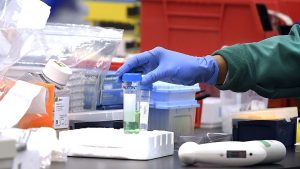When United Automobile Workers members walked off the job at 33 General Motors sites around the US on Sunday morning, perhaps the most … striking detail was that they only numbered 46,000. The last time the UAW’s GM workers went on strike, in 2007, they were 73,000 strong. And that was a fraction of the 259,000 US hourly production workers GM employed in 1991.
UAW membership has ticked upward in recent years, recovering from its post-financial-crisis nadir. Now it faces a new threat from the next great shift for the auto industry. The electric car may be great for the planet and glorious for drivers, but it’s no good for jobs.
Want the latest news on electric vehicles in your inbox? Sign up here!
In talks for a new contract with the union, GM offered to create 5,400 new jobs, invest $7 billion in various facilities, and increase wages and benefits. Among other demands, the UAW wants a greater share of GM profits—the automaker has reported $35 billion in operating profit in North America over the past three years—and for GM to reopen an Ohio plant it closed in March. GM announced the closure of that plant, in Lordstown, late last year, along with job cuts and the elimination of many sedan and compact models. It has balanced that withdrawal with plans to introduce 20 new, all-electric models by 2023, its first big step in an $8 billion bid to (someday) stop building gas- and diesel-powered rides altogether.
That change comes with a worrisome footnote for auto workers around the world. Last year, a study by Germany’s Fraunhofer Institute for Industrial Engineering IAO found that by 2030, a moderate shift to electric propulsion could leave 75,000 Germans out of work—even accounting for the creation of 25,000 new jobs. That’s because batteries and motors are far simpler machines than internal combustion engines, and require a few hundred parts instead of a few thousand. That’s the same reason maintenance costs for EVs are so low—a problem for dealerships that rely on servicing cars for profits. Fewer parts mean fewer people.
In 2017, Ford CEO Jim Hackett, discussing his company’s plans to invest big in electrics, told investors that Ford could reduce time spent building EVs by 30 percent, compared with conventional vehicles, according to Reuters. When industry supplier Continental announced a shift away from building internal combustion engine powertrains, it also predicted job cuts. Hyundai’s auto union chief, Ha Bu-young, told Reuters that “electric cars are disasters. They are evil. We are very nervous.”
The UAW itself has found that American automakers’ move away from exploding petrol could do away with 35,000 jobs in the next several years. “EV powertrains are simple compared to internal combustion engines. The simplicity could reduce the amount of labor, and thus jobs, associated with vehicle production,” the union’s research chief, Jennifer Kelly, said in March.
Of course, electric cars aren’t the only, or the first, automotive trend limiting the demand for auto workers. The industry has become more efficient and streamlined in building all kinds of cars, says Kelley Blue Book analyst Karl Brauer. Vehicles are simpler and automakers now share more parts between makes and models. Brauer notes the shift from carburetors to fuel injectors made for simpler mechanics—and fewer hours of work on each vehicle. “EVs are just another step,” he says.
The news is not all grim for assembly line workers. In contract negotiations, GM reportedly talked about building its upcoming electric pickup truck in Detroit, and manufacturing battery cells in Ohio. (GM declined to make a spokesperson available for this story.) After all, GM’s future may not include gasoline, but it’s not giving up on automobiles anytime soon—and it’ll still need at least some United Automobile Workers to stick around.
Note: The author’s partner is a member of UAW Local 2865, which represents University of California graduate student instructors, teaching assistants, tutors, and readers.
More Great WIRED Stories
- A detox drug promises miracles—if it doesn’t kill you first
- Artificial intelligence confronts a “reproducibility” crisis
- How rich donors like Epstein (and others) undermine science
- Hacker Lexicon: What are zero-knowledge proofs?
- The best electric bikes for every kind of ride
- 👁 How do machines learn? Plus, read the latest news on artificial intelligence
- 🏃🏽♀️ Want the best tools to get healthy? Check out our Gear team’s picks for the best fitness trackers, running gear (including shoes and socks), and best headphones.



